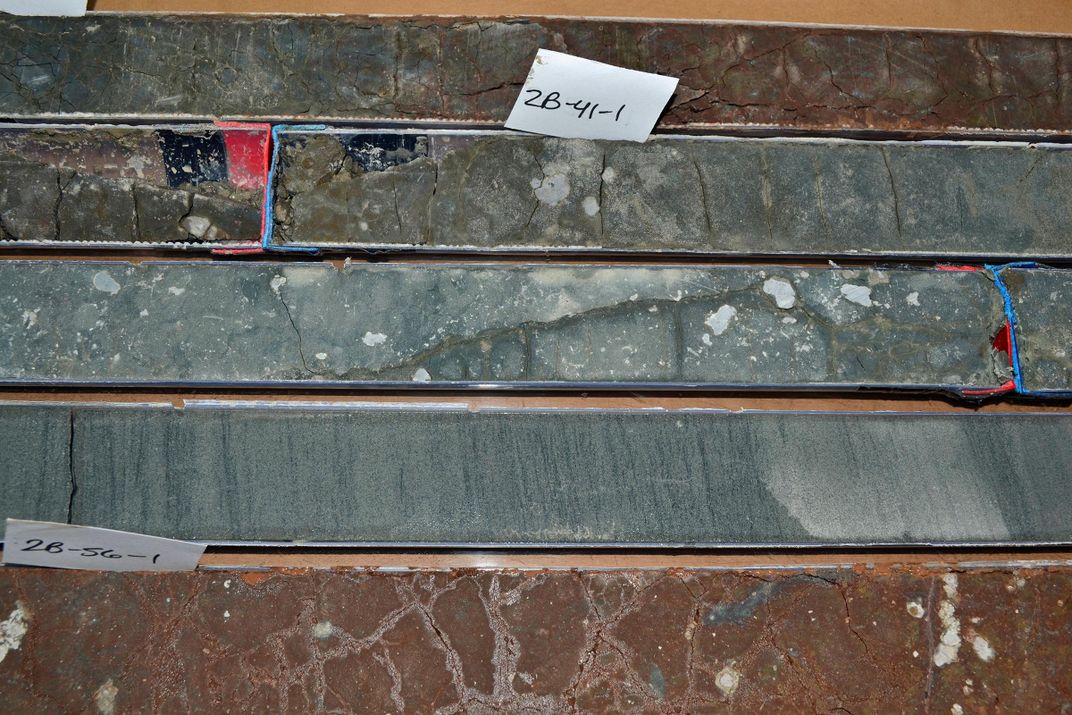Ancient Earth Warmed Dramatically After a One-Two Carbon Punch
A period of intense warming 55 million years ago is an even better case study for modern climate change than previously suspected
/https://tf-cmsv2-smithsonianmag-media.s3.amazonaws.com/filer/e6/0d/e60d25b3-4d04-4154-b3bd-ac7ae6f567e7/42-32191574.jpg)
A spell of severe global warming 55 million years ago was triggered by not one but two injections of greenhouse gases into the atmosphere—and the rate of increase suggests that the ancient warming event may hold important lessons for what to expect with today’s climate change.
One of the best ways to explore how human-induced global warming will affect Earth in future is to study the way our planet responded to climate change in the past. Many researchers think the Paleocene–Eocene Thermal Maximum (PETM) 55 million years ago is particularly relevant to our current situation, because it also involved a massive injection of carbon into the atmosphere that led to spiraling global temperatures.
Not all researchers have been convinced we have much to learn from the PETM, though. Some studies suggested the climate back then changed far more slowly than it is changing now, with atmospheric carbon building up gradually over about 20,000 years, perhaps because of the slow release of volcanic gases. Still other studies concluded that the PETM changes occurred far too rapidly for comparisons with our present situation. A study last year suggested that atmospheric carbon soared within just a few years, maybe due to a massive influx of carbon from a comet impact.
But the latest geological evidence, published today in Nature Geoscience, makes these “too-slow” and “too-fast” warming scenarios begin to look unlikely. Instead, the rate of change was probably “just right” for making modern comparisons.
Researchers led by Gabe Bowen at the University of Utah drilled an 820-foot core out of the ground near Powell, Wyoming. Their sample cuts through ancient soils—now turned to stone—that formed before, during and after the PETM. The soil layers contain thousands of carbonate nodules, each of which holds varieties of carbon that reflect the composition of the atmosphere at the time the nodule formed. By measuring these varieties, or isotopes, within each nodule, the researchers could build a picture of how carbon was added to the ancient atmosphere. It isn’t the first time researchers have built such a carbon record for the PETM—similar profiles have been made using information from marine sediment cores. But marine sediments get churned up by burrowing animals, blurring the detail of the carbon picture in a way that doesn’t happen so readily on land, say the researchers.

The results show that carbon was pumped into the atmosphere over a period of a few thousand years—roughly at the same pace as today’s emissions. They also found that at least 992 million tons of carbon entered the atmosphere per year—that's within an order of magnitude of today’s annual rate of 10.5 billion tons.
But perhaps the most interesting finding was that the PETM seems to have involved two separate carbon pulses. A few thousand years before the PETM got into full swing, there was a short-lived period of global warming. Atmospheric carbon levels shot up over the course of perhaps 1500 years, stayed high for a millennium or so then rapidly returned to normal. After another couple of millennia, carbon levels shot up again—but this time they stayed high for tens of thousands of years, causing the true PETM event.
“This is the first strong evidence that there were these two pulses very closely spaced in time,” says study co-author Scott Wing, a paleobiologist at the Smithsonian's National Museum of Natural History. It’s a significant observation, he says, because it means we can better assess exactly what triggered the PETM. “It’s almost embarrassing that we haven't worked out a cause yet,” says Wing. “It’s the first thing anyone wants to know—but even 20 years after identifying the PETM we’re still arguing about the cause.”
The new results appear to rule out the very slow, volcanically induced scenario—the carbon entered the environment too quickly for that to work. And because there were two distinct pulses of warming, the comet scenario looks weak too. “You’d need to have two separate comets then—it sounds a little like special pleading,” says Wing.
/https://tf-cmsv2-smithsonianmag-media.s3.amazonaws.com/filer/4b/7e/4b7e9def-70ec-4b2b-9531-39f8160fe120/scottwingwithcore.jpg)
Instead, the authors argue that a release of methane from deposits below the seafloor would explain both the rate of change and the curious double pulses. This methane is normally safely locked away in a solid form called methane clathrate, but even an undersea landslide might have been enough to destabilize an area of the seafloor and unlock a vast clathrate deposit. That kind of event could have triggered the short-lived pulse of global warming before the main PETM event.
In response to this initial pulse, Earth’s oceans might have soaked up the excess atmospheric heat. If they did, though, it’s possible that this natural recovery mechanism triggered the main event. Warmer oceans can themselves destabilize clathrate deposits, which might explain where the second carbon pulse came from, says Wing. If this scenario is correct, it makes the PETM even more relevant to today—the oceans are warming up once more, and clathrate deposits below the seafloor are again beginning to destabilize.

“I was a bit skeptical about the study at first—soil carbonates are usually difficult to interpret,” says Henrik Svensen at the University of Oslo, Norway. “But it seems like a nice and thorough study that indeed adds new perspectives to the PETM.” What isn’t clear, adds Svensen, is why the double pulse hasn’t really turned up clearly in other studies, given that several groups of geologists working elsewhere in the world have used carbon isotopes in rocks to reconstruct atmospheric conditions during the PETM in relatively high detail.
Other researchers say they have seen hints of the two pulses in their earlier studies. For instance, Ying Cui and Lee Kump at Pennsylvania State University and their colleagues published an analysis in 2011 of carbon isotopes in PETM marine sediments off the coast of Spitsbergen in the Arctic Ocean. “We identified two pulses as well, related to steepenings and flattenings in the carbon isotope record,” says Kump.
Even so, not everyone is convinced that the latest evidence sounds the death knell for previous warming scenarios. James Wright at Rutgers University co-authored last year’s paper arguing that the PETM warming occurred quickly, perhaps due to a comet. Because the new results show atmospheric conditions returned to normal between the first and second pulse, we can’t be sure that the first pulse has any direct relevance to the PETM, he counters. This would leave the way open for the second pulse to be exclusively responsible—which means we can’t completely rule out the comet scenario.
If Wing and his colleagues are correct and the PETM global warming event is similar to today’s, we know it’s not a perfect comparison. The world was a very different place 55 million years ago. For instance, even before the PETM, the planet was already so warm that there were no ice caps. Nor should we take too much comfort from the fact that the PETM didn’t cause a major mass extinction, says Wing, because while current global warming doesn’t threaten the existence of our species, it does threaten our way of life. “What we’re talking about is massive changes that could cause a rather unbelievable amount of human suffering and loss of the things we all hold dear,” he says.